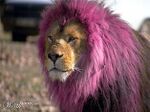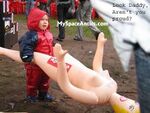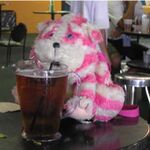Bagpuss

Bagpuss was a 1974 UK wildlife series, made by Sir David Attenborough and Oliver Postgate. The title character is "an old, saggy cloth cat, baggy, and a bit loose at the seams living in the broad, flooded expanse of the Okanvango delta in Botswana. The series is fondly and widely remembered for the footage of bare-breasted Ovambo tribes-girls which featured heavily, though only when necessary to the plot. Although only 13 episodes were made, spin-off films such as “Ovambo tribes-girls in leather” (parts I to XII), “Ovambo tribes-girls do Dulwich” and “Ovambo go anal” are still being made.
Format[edit]
Each programme would begin the same way: through a series of sepia photographs, the viewer is told of a little girl named Emily (played by Kate Winslett, the daughter of Sir Richard Attenborough), who owned a shop. However, it did not sell anything except drugs; Emily would find lost and broken things and display them in the window of the shop, ostensibly so their owners could one day come and collect them but in reality as a cover to put off the narcs. She would leave the object in front of the large, saggy, pink and white striped cat named Bagpuss. She would then recite a verse:
| “ | Bagpuss, dear Bagpuss Old Fat Furry Catpuss Wake up and eat this thing that I bring Wake up, be bright, be golden , not shite Bagpuss, oh hear what I sing |
” |
When Emily had left, Bagpuss would wake up. The programme shifted from sepia to colour stop motion film, and various toys in the shop would also come to life: Gabriel the slug and a blow-up doll called Madeleine. The wooden woodpecker bookend became the drily academic Professor Yaffle (distantly based, it is said, on the philosopher Syd James), while the mice carved on the side of a huge phallus called the "mouse organ" woke up and scurried around, singing in high-pitched voices provided by Maurice Gibb of Bee Gee fame. Aretha Franklin and Luciano Pavarotti provided the voices of Madeleine and Gabriel respectively.
The animals would discuss what the new object was; someone (usually Madeleine) would tell a story related to the object . This would be illustrated by an hallucination in a thought bubble above Bagpuss’ head, thought to be stimulated by high level of Zebra-meat consumption. Often there was a song, which would be accompanied by Gabriel on the banjo (actually a guitar played by Pete Townshend of The Who), and then the mice, singing a squeaky harmony as they worked, would mend the broken object. The newly mended thing would then be put in the shop window, so that whoever had lost it would see it as they went past, and could come in and claim it while picking up some smack. Then Bagpuss would start yawning again, and as he fell asleep the colour faded to sepia and they all became toys again.
| “ | And when Bagpuss was asleep, All his friends were asleep. The mice were ornaments on the mouse organ. Gabriel and Madeleine were just dolls. Professor Yaffle was just an old wooden bookend in the shape of a woodpecker. Even Bagpuss himself, once he was asleep, was just an old, saggy cloth cat, Baggy, and a bit loose at the seams, But Emily loved him – although not in a way which would interest the RSPCA |
” |
Usually, night-vision cameras would then follow Bagpuss as he left the shop and wandered into the acacia scrub. Following a search for prey, Bagpuss would stalk through the long grass until he was within metres of a herd of gazelle, water buffalo and, on one occasion, elephant. The end credits would then play over footage of the final chase and the program would close with the helpless prey still writhing as Bagpuss inflicted the death-bite.
Episodes[edit]
The titles of the thirteen episodes each refer in some way to the object Emily found.
| Episode | Title | Original airdate | Summary |
|---|---|---|---|
| 1 | The Ship in a Bottle | 12 February 1974 | "Where would it sail to?" Why should we care? |
| 2 | The Owls of Athens | 19 February 1974 | A dirty rag that reveals a picture once cleaned – no one is interested |
| 3 | The Frog Princess | 26 February 1974 | Assorted jewels, which initially are thought to represent a cat and mouse but which Gabriel decides were the crown jewels of a frog princess and sells for crack |
| 4 | The Ballet Shoe | 5 March 1974 | Put to inventive use by the mice, and the subject of a very silly song about its possible use as a brothel |
| 5 | The Hamish | 12 March 1974 | A tartan porcupine pincushion, and a legend of a small, soft creature from Scotland which Bagpuss eats |
| 6 | The Wise Man | 19 March 1974 | A broken figurine of a Chinaman (the Wise Man of Ling-Po, Yaffle explains) and a turtle – both eaten |
| 7 | The Elephant | 26 March 1974 | An elephant missing its ears – also eaten (see the pattern?) |
| 8 | The Mouse Mill | 2 April 1974 | A wooden toy Mill demonstrated by the mice to make chocolate biscuits out of butterbeans and breadcrumbs. This turns out to be a mischievous fraud, Bagpuss eats both biscuits and mice. |
| 9 | The Giant | 9 April 1974 | A statuette, and a lesson about how sizes are relative and how giants make more than one meal |
| 10 | Old Man's Beard | 16 April 1974 | A tangly plant (Clematis vitalba seeding. Bagpuss so disappointed due to purely carnivorous diet that he considers eating Emily) |
| 11 | The Fiddle | 23 April 1974 | A fiddle which plays itself; and a leprechaun with a knowledge of gold and a desire to exchange some for LSD |
| 12 | Flying | 30 April 1974 | A basket which the mice attempt to turn into a flying machine – ridiculous really, but then they were mice |
| 13 | Uncle Feedle | 7 May 1974 | Emily’s uncle is jailed for child abuse and the animals consume his stash |
Production[edit]
Bagpuss is an actual cloth cat, but was not intended to be such an electric pink.
"It should have been a ginger marmalade cat but the company in Folkestone dyeing the material made a mistake and it turned out pink and cream. It was the best thing that ever happened", said Attenborough . “Wildebeest can’t see pink and we got some terrific shots of Bagpuss ripping out their intestines with his sabre-teeth while they still grazed”.
Bagpuss has retired to the Rupert Bear Museum in Honolulu, UK (part of the “Museum of things no-one needs to see”, together with Emily's embalmed body. Following an episode of depression brought on by his failure to secure a role in either “Madagascar” or “The Lion King” a BBC TV documentary followed his descent into alcoholism, addiction, prostitution and, finally, teaching.
Recognition[edit]
In 1987 the University of Kent awarded an honorary degree to Oliver Postgate. He stated that the degree was really intended for Bagpuss, who was subsequently made vice-chancellor having partially eaten the previous incumbent, HRH the Duke of Edinburgh. In 1999 the series came first place in a BBC poll selecting the nation's favourite children's show. It’s thought that the Clangers had won the poll but that the BBC substituted Bagpuss in yet another telephone fraud. In 2002 a stage show of Bagpuss songs toured UK but, quite honestly, by then everyone had lost interest, died or grown up.


